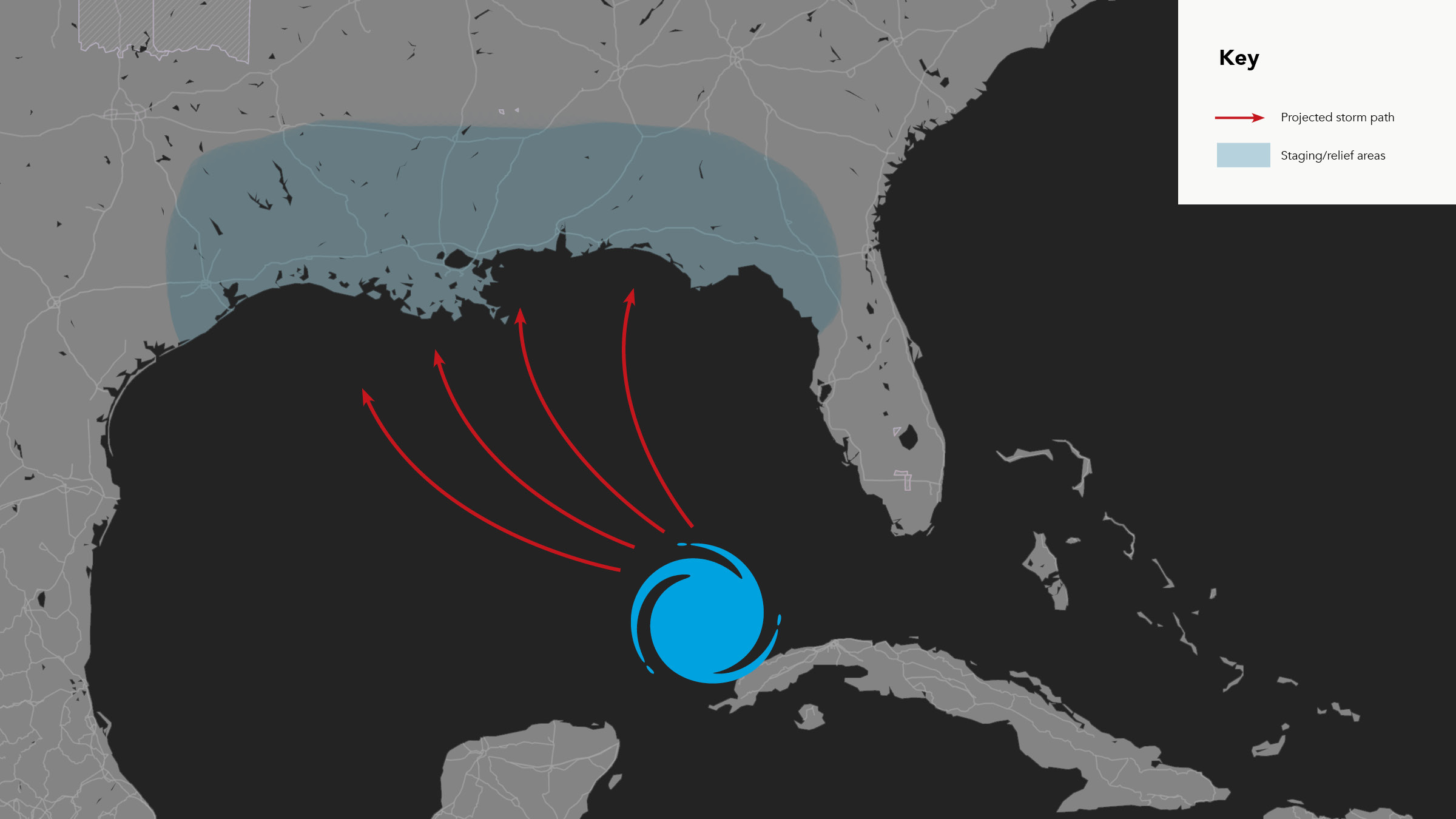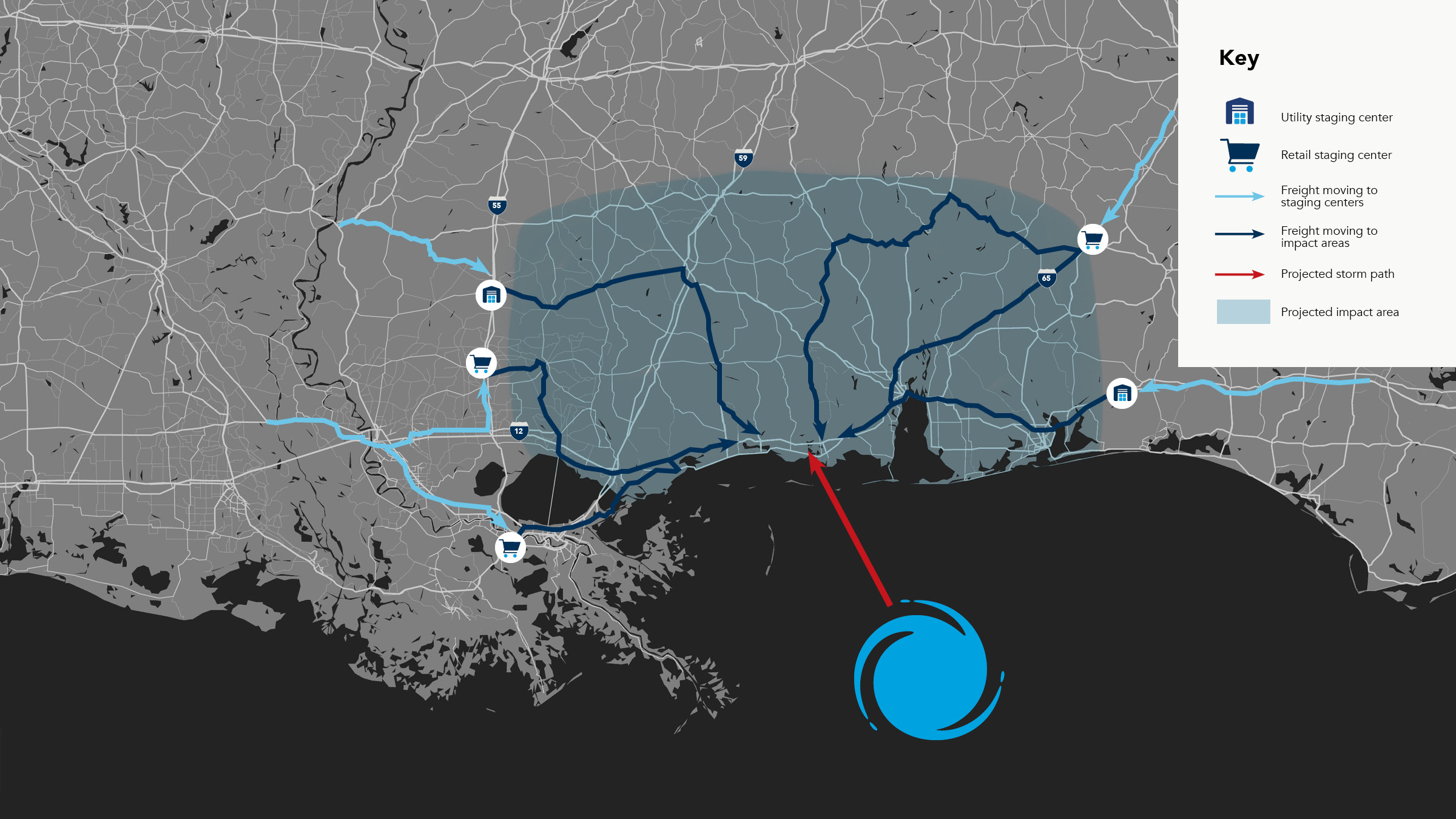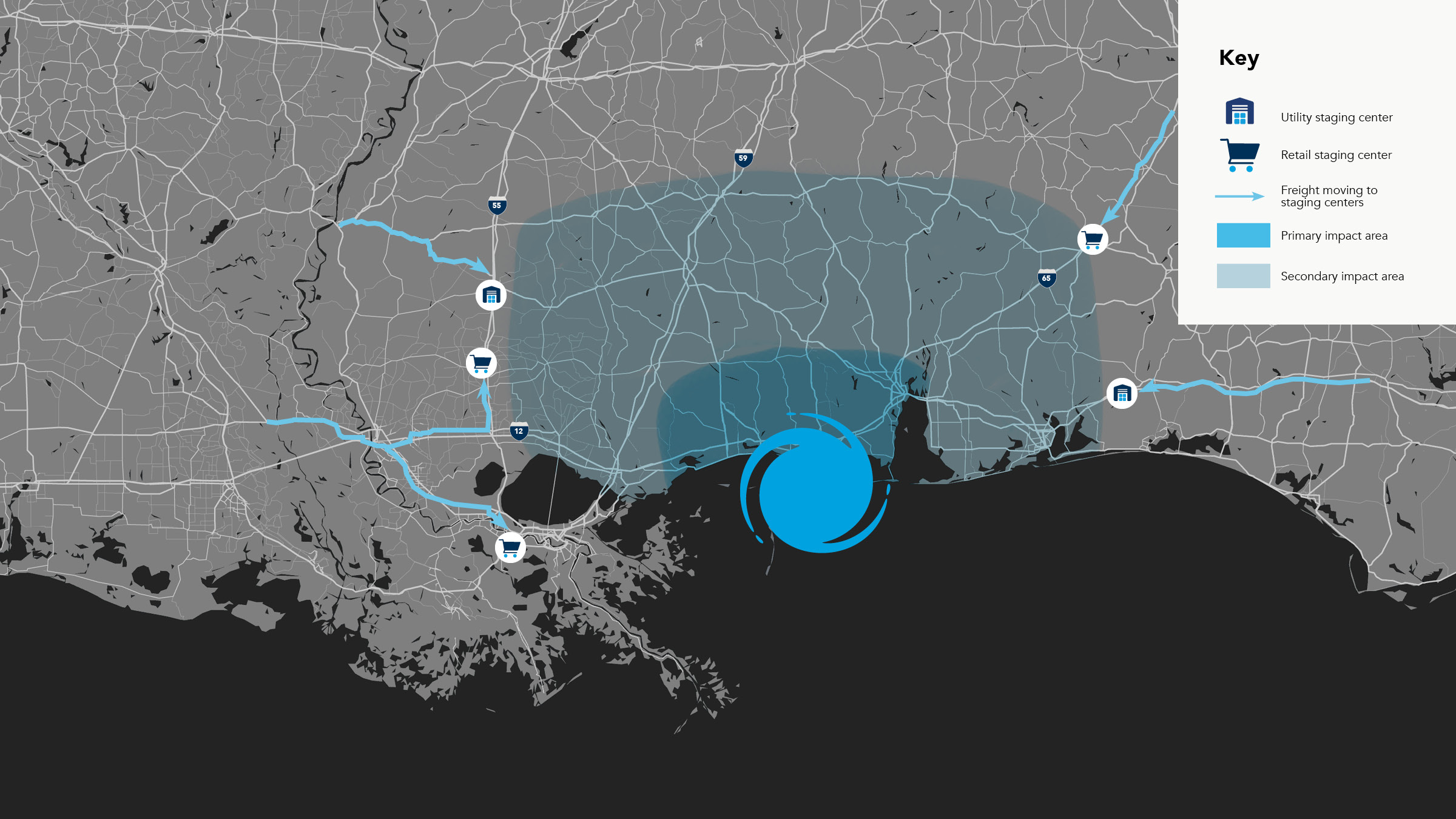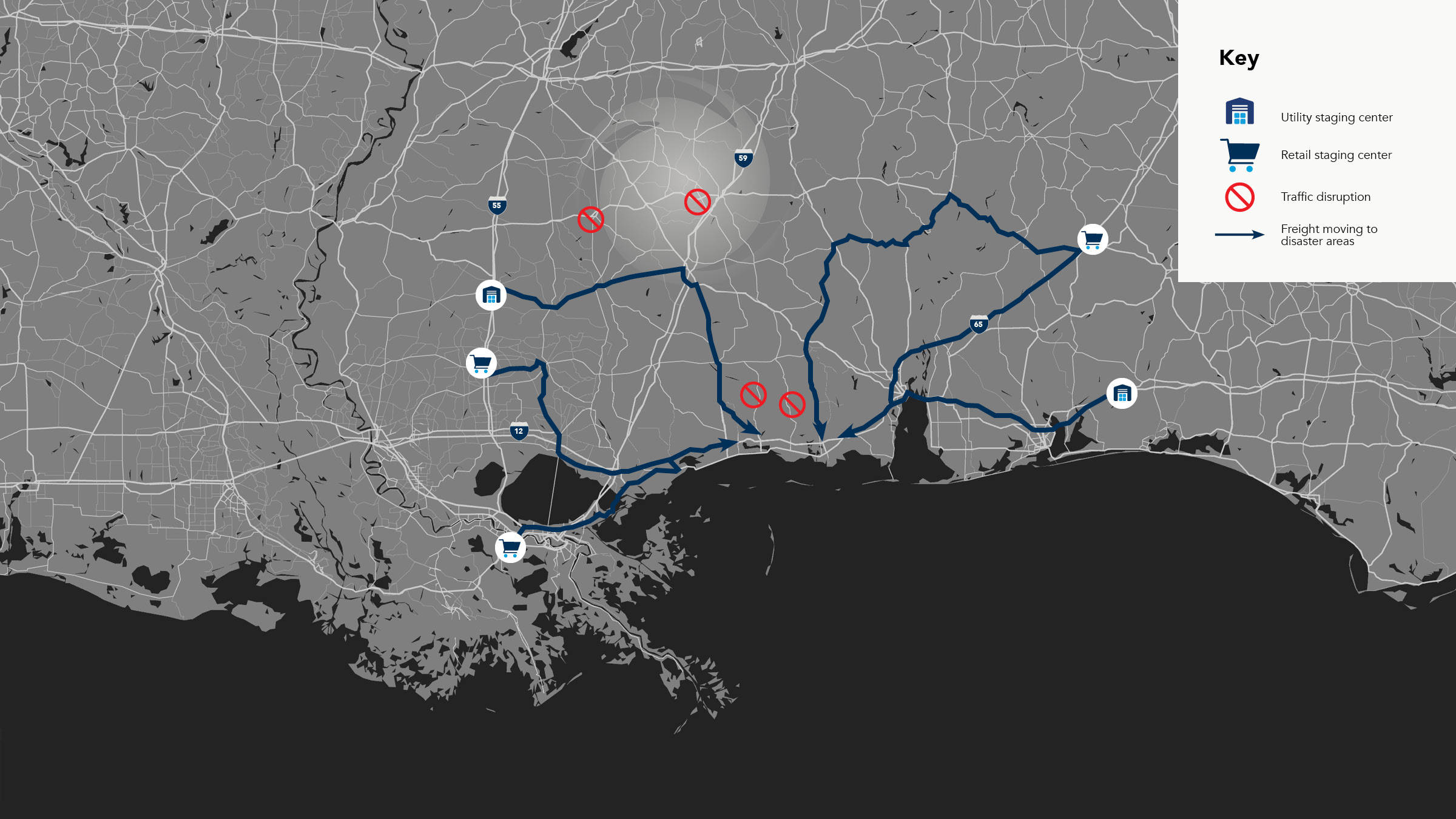For logistics leaders, hurricane season brings a unique set of challenges. Beyond the immediate human impacts and widespread material damage, storms can disrupt supply chains, delay shipments, and create ripple effects across entire industries. In recent years, those challenges have grown more complex.
Storms are affecting broader regions and triggering more widespread disruptions—from port closures to inland flooding. Between 2016 and 2024, according to the National Oceanic and Atmospheric Administration (NOAA), the U.S. was struck by 29 hurricanes and tropical storms that caused at least $1 billion in damage each more than $800 combined, which adds up to an enormous amount of rebuilding.
That scale of disruption underscores just how critical logistics has become. When a hurricane strikes, a lot of things must move—in a hurry. That is especially true for sectors like retail and energy, which are intimately involved in preparation, recovery and resilience, but also for the rest of the regional economy, which sees its supply chains disrupted.
How do you reconfigure complex logistics operations in real time so that essential supplies get to the disaster area and regional freight can keep moving as normally as possible? It’s a problem that nobody solves better than C.H. Robinson, with its unmatched scale, experienced crisis logistics experts and 450,000+ network of carriers able to flex to any need as it arises.
Here’s how it happens.
The countdown begins

A big hurricane is on track to hit the U.S. Gulf Coast, causing trepidation from Houston to the Florida panhandle. As people start to make plans to board up their homes and evacuate, or rush to stock up on supplies to ride out the storm, C.H. Robinson activates its well-drilled playbook and the company’s multidisciplinary disruption team convenes. Their mission: Keep customers’ supply chains going so they can serve their communities with as little disruption as possible.
Communications:
- As the hurricane begins its approach, C.H. Robinson’s experts analyze the forecasts. They identify the areas most likely to be impacted, assess how the storm may affect customers’ logistics operations and start formulating plans to circumvent disruptions.
- At this point, situational awareness is paramount. The first advisories go out to customers and carriers operating in the at-risk area.
Retail and energy:
- Sophisticated utilities and retail chains know what to do when a hurricane is headed their way. Many of C.H. Robinosn’s customers have their own playbooks. Often, these include strategically located warehouses to preposition essential goods—far enough from the coastlines to be safe, but close enough to ship goods to the disaster areas fast.
- The most experienced customers have gone over these plans with C.H. Robinson experts well before hurricane season, so all involved know exactly what to do. Now, it’s go-time.
- But even those that haven’t done all the prep work can call on us when a hurricane hits. Although nothing beats planning, no other logistics provider can scale up and mobilize capacity in a pinch like C.H. Robinson.
The hurricane is locked in

Now that the storm’s path is clear, activity ramps up. As the first bands of wind and rain begin to disrupt traffic, carrier availability and pricing can swing significantly. But nobody is better placed to navigate this highly volatile environment than C.H. Robinson. Thanks to its network and relationships, the company can connect shippers with the capacity they need to keep essential goods moving until the last moment.
Communications:
- As soon as it becomes clear where the storm will hit, C.H. Robinson begins to issue more precise, real-time advisories with the information shippers and carriers depend on to keep supply chains going: weather updates, affected areas, road closures and alternatives, power outages, market information—for the duration of the storm, the Robinson disruption team will provide detailed, actionable information frequently.
Retail:
- Large retailers now know where to safely preposition their supplies: close to ground zero, but out of the projected path of the storm. At the same time, they ship hurricane essentials to locations in the expected landfall area to keep shelves stocked as much as possible. This includes crucial supplies like water, non-perishable foods, batteries, plywood and generators.
- As a result, freight traffic spikes. Sites that normally receive less than a handful of shipments a week can now see as many as ten or twenty. C.H. Robinson finds the carriers required to handle this surge, at the best rates. As the largest provider of logistics capacity in North America, we are better equipped than anybody to connect shippers and carriers in the run-up to an extreme weather crisis.
Energy:
- Local utilities are getting ready to start restoring power as fast as possible once the storm clears out. Following their own plans, they stock up on transformers, cables and other electric gear, and preposition recovery crews.
- C.H. Robinson takes the utilities’ cues and ensures they have the trucking capacity for their preparations.
Zero hour: The storm hits

The storm makes landfall as a category 4 hurricane. Sustained winds exceed 140 mph. Roads are flooded. Power fails. Many buildings suffer catastrophic damage. But what wall-to-wall television coverage doesn’t show is the huge logistics operation that continues away from ground zero. Further inland, the outer bands of the storm can cause supply chain hiccups in the form of uprooted trees, flooded roads and other disruptions.
Communications:
- No blackouts, no downtime. As the hurricane hits, C.H. Robinson stays online 24/7. Through hourly updates, customers and carriers get real-time visibility into freight status, delays, and alternate routes.
- Meanwhile, we keep monitoring pricing signals. If market rates jump, we usually know before it happens—and so do the customers and carriers who count on us.
Retail:
- Away from ground zero, C.H Robinson continues to help customers stockpile essential supplies, ready to be shipped out again for the recovery operation as soon as the storm passes.
- This often means adapting to a situation that can change by the minute and rerouting freight around road closures and flooded interstates.
Energy
- In the towns and counties that are taking a direct hit from the hurricane, the power is out. Utility crisis teams are monitoring the evolving situation from their stormproof crisis centers.
- C.H. Robinson is there with them, tracking their priorities and ready to route recovery teams and critical supplies to the hardest hit areas as soon as it is safe.
The rebuild begins

In the hurricane-stricken areas, the recovery operation can start. In some cases, supply chains transition back to normal within a few weeks. But after a big storm that causes large-scale devastation in a densely populated area, rebuilding can take months or even years. The removal of many thousands of tons of debris alone can require a whole separate logistics operation.
Communications:
- The remnants of the storm can still cause significant damage moving inland. For that reason, C.H. Robinson keeps issuing updates until weather and traffic are definitively back to normal.
- At the same time, the disruption team starts debriefing internally and with customers—what worked, what didn’t and what are the lessons for next time? The C.H. Robinson disaster playbook is always a work in progress. Every storm is an opportunity to get better at the job.
Retail:
- It is time to reopen and replenish. As rebuilding supplies fly off the shelves, C.H. Robinson helps retailers restock stores and staging centers. Thanks to the company’s broad network, deliveries often start before the competition can even get trucks on the road.
- Where buildings have been heavily damaged, Robinson supports temporary retail setups, such as mobile units and pop-up stores in parking lots.
Energy
- The local utility’s number one priority is to restore service as quickly as possible so that life can begin to go back to normal. This can mean big repairs requiring many truck loads, but also “milk runs” with single box trucks or cargo vans to help crews address smaller issues.
- Since power company workers stay in the field 24/7 until the job is done, C.H. Robinson also transports tents, cots, food and even laundry.
The bottom line
When a storm hits, communities don’t care about excuses. They care about results—and C.H. Robinson delivers.
- For shippers and carriers: We’re an information and expertise hub that connects nodes in the network and keeps critical freight moving.
- For energy providers: We help restore power faster, safer, and smarter.
- For retail: We keep shelves stocked and communities supplied.
- For everyone: We help bring scale, speed, and certainty in the most uncertain moments.
What The C.H. Robinson disruption team has learned is that preparation is everything. That’s why they train for these events year-round. And it goes beyond hurricanes. Whether it’s floods, wildfires or catastrophic winter storms, a successful response begins with effective logistics.
To learn how you can get ready, explore our Emergency Response Logistics Guide.